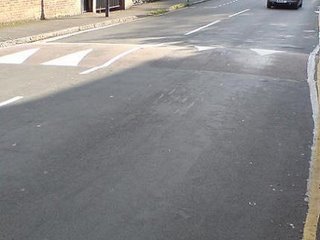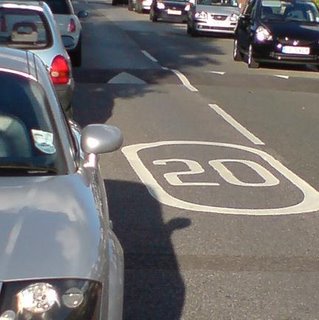Many councils have ongoing policies which each year introduce new 20mph zones in to residential areas. From a cycling point of view: Who cares? & Do they work?
20mph zones are more enjoyable to cycle, for exactly the reasons of relative speed posted about here. Two and four wheeled traffic generally flow more harmoniously in these traffic calmed areas.
When first introduced to my local area, there was the occasional idiot car driver who was desperate to scream past my bike, earning a tank slapping "boof" as he scrapes something expensive on a speed hump...
But it seems most people become used to the safer speed, albeit by force and not choice. I guess it's a demonstration of selfish culture, that 20mph zones only work when enforced by the physical impracticalities posed by speed humps. Meh.
Cycling
Up to 20mph on flat, is a speed accessible to most cyclists, perhaps not always if the wind direction is against them, but certainly if the wind is coming from behind them, giving some welcome assistance.
I find the short wheelbase of a bicycle means I can ride over speed humps effortlessly quicker than cars do. Whereas in my car I have to slow right down, or else risk damage to the undercarriage (as previous drivers have found out, judging by the wounded tarmac above).
Minefield
The majority of residential roads are a minefield of potential hazards, often with dense rows of parked cars making visibility quite obscured. E.g. Who knows when a family cat might run out from underneath parked cars? Or when a car door may be unexpectedly swung open? Or when a football rolls in to the road, chased by a child? Or when cars reverse from driveways after an obscured bend?
In places like London, these crowded & populated urban & sub-urban settings are so widespread, that I feel many people become comfortable and nonchalant with the density, to the extent it is quite natural to drive through residential roads at excess speeds which don't acknowledge the ever-present residential hazards.
Criticism
20mph zones, although employing rigorous physical deterrents, still often don't enforce the 20mph limit. When the speed humps are spaced too far apart, modern cars are easily hitting 30mph -40mph on the flat spaces between speed humps: Nullifying any calm and safe cycling evironment a 20mph zone may have set out to promote.
By spacing road humps closer together, traffic planners could make a 20mph zone genuinely successful - so that by the time a car (even a high performance car) accelerates to 20mph, it has to slow for the next imminent speed hump.
Idea
But is there any need for speed humps at all? Here's an idea:
Consider the technology already in use:
- Cruise control - The car automatically maintains a constant chosen speed.
- Electronic maximum speed limiters - Although a car can potentially go faster, manufacturers impose restricted maximum top speeds (e.g. 155mph).
- GPS route navigation (e.g. Tom Tom / Garmin / Navman / etc ).
It is only a short hop of imagination to combine the existing technology to eliminate dangerous speeding in residential areas.
Given that each individual speed hump costs around £1,000, GPS nationwide could be a whole lot cheaper & smoother method of managing the speeding problem.
Consider that the GPS finds your route, and knows your location. As easy as it is to know about hotels in the area, the GPS device could similarly be programmed to know the speed limit of the present road. If the GPS could talk to the car's engine management system, the two would guarantee speed limits are not exceeded.
This idea would generate a double benefit of safer traffic speeds through neighbourhoods, and reassurance the driver will never be caught speeding and suffer the fines and penalty points which go with it.
Given satellite navigation has become much cheaper recently, and is even sold as standard on some cars, this whole idea could be easily distributed as people renew their cars. Even if only 1 in 10 cars benefited from GPS speed management, all the cars in traffic following behind, would also be affected, in an ad-hoc Pace Car kind of situation.
Summary
- 20mph a better traffic speed to cycle amongst.
- Bikes less affected than cars over speed humps.
- 20mph is required because people become accustomed to speeding in residential areas.
- Speed humps only effective when continually located close to the next one.
- GPS speed management is a cheap & easy near-future solution.
Technorati Tags:
GPS Speed Management
Speed Humps
20mph Zones
Cycling Blog




2 comments:
Hi - as a cyclist I personally detest speed humps.
There is a considerable short-cut on my way home, which (doubtlessly because it became a rat-run) has been filled with extremely harsh humps. As a result I often avoid these roads, and instead stick to the A13.
I find the humps batter my bike, and adversely affect my riding rhythm (it's a fixed-wheel bike so I can't freewheel). Also, could I get the council to pay for broken spokes, incurred at under 20mph because of a savage hump? I think not.
Another concern is emergency vehicle access. Ambulances in particular are negatively affected by speed humped zones. Not good. I think speed-sensing traffic lights are a much better idea (i.e. you go through a radar trap at over 25mph, for example, and a red light 200m away is switched).
In answer to your previous question - yeah, I do own all the bikes! Call it an addiction. I'm helpless! :-)
Yeah I'm certain everyone would prefer no need for speed humps at all. If drivers' speed through residential areas wasn't so consistently high, there would be no requirement for speed humps in the first place.
What these mini-mountains do well though, is force drivers to slow down. Compared to other initiatives like speed-cameras (which slows people down for 20 meters at best) or speed limit signs (which are pretty much wholly ignored!), speed humps succeed in their single-purpose task.
I like the sound of speed-sensing-traffic lights. But straight away can see that would be chuffin expensive! In my locality, traffic lights are only on major junctions, and not in the residential estates, which are generally the quieter road-meets-road uncontrolled type junctions.
Post a Comment